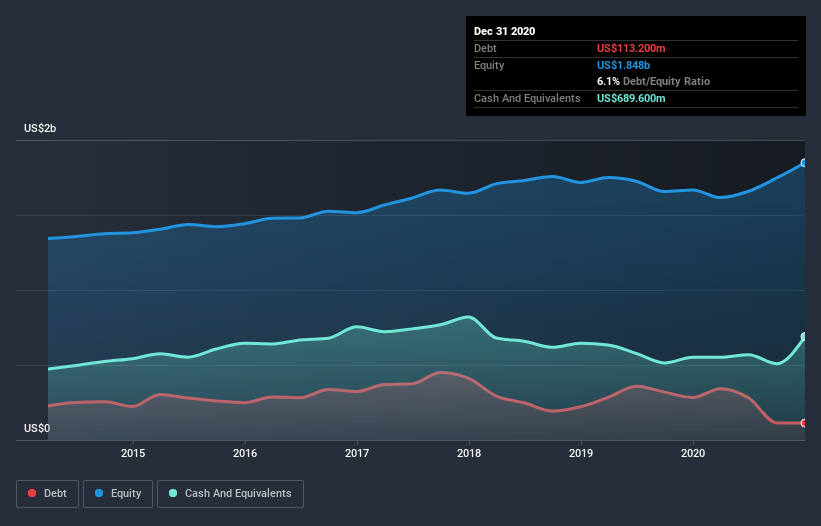Is A. O. Smith (NYSE:AOS) A Risky Investment?
The external fund manager backed by Berkshire Hathaway's Charlie Munger, Li Lu, makes no bones about it when he says 'The biggest investment risk is not the volatility of prices, but whether you will suffer a permanent loss of capital.' When we think about how risky a company is, we always like to look at its use of debt, since debt overload can lead to ruin. Importantly, A. O. Smith Corporation (NYSE:AOS) does carry debt. But the more important question is: how much risk is that debt creating?
When Is Debt A Problem?
Debt and other liabilities become risky for a business when it cannot easily fulfill those obligations, either with free cash flow or by raising capital at an attractive price. If things get really bad, the lenders can take control of the business. However, a more usual (but still expensive) situation is where a company must dilute shareholders at a cheap share price simply to get debt under control. Of course, plenty of companies use debt to fund growth, without any negative consequences. When we think about a company's use of debt, we first look at cash and debt together.
Check out our latest analysis for A. O. Smith
What Is A. O. Smith's Net Debt?
You can click the graphic below for the historical numbers, but it shows that A. O. Smith had US$113.2m of debt in December 2020, down from US$284.0m, one year before. But it also has US$689.6m in cash to offset that, meaning it has US$576.4m net cash.
How Strong Is A. O. Smith's Balance Sheet?
The latest balance sheet data shows that A. O. Smith had liabilities of US$886.3m due within a year, and liabilities of US$426.1m falling due after that. On the other hand, it had cash of US$689.6m and US$585.0m worth of receivables due within a year. So it has liabilities totalling US$37.8m more than its cash and near-term receivables, combined.
This state of affairs indicates that A. O. Smith's balance sheet looks quite solid, as its total liabilities are just about equal to its liquid assets. So while it's hard to imagine that the US$9.99b company is struggling for cash, we still think it's worth monitoring its balance sheet. Despite its noteworthy liabilities, A. O. Smith boasts net cash, so it's fair to say it does not have a heavy debt load!
On the other hand, A. O. Smith saw its EBIT drop by 3.9% in the last twelve months. That sort of decline, if sustained, will obviously make debt harder to handle. There's no doubt that we learn most about debt from the balance sheet. But it is future earnings, more than anything, that will determine A. O. Smith's ability to maintain a healthy balance sheet going forward. So if you want to see what the professionals think, you might find this free report on analyst profit forecasts to be interesting.
Finally, a company can only pay off debt with cold hard cash, not accounting profits. A. O. Smith may have net cash on the balance sheet, but it is still interesting to look at how well the business converts its earnings before interest and tax (EBIT) to free cash flow, because that will influence both its need for, and its capacity to manage debt. During the last three years, A. O. Smith generated free cash flow amounting to a very robust 87% of its EBIT, more than we'd expect. That positions it well to pay down debt if desirable to do so.
Summing up
While it is always sensible to look at a company's total liabilities, it is very reassuring that A. O. Smith has US$576.4m in net cash. The cherry on top was that in converted 87% of that EBIT to free cash flow, bringing in US$505m. So is A. O. Smith's debt a risk? It doesn't seem so to us. There's no doubt that we learn most about debt from the balance sheet. However, not all investment risk resides within the balance sheet - far from it. We've identified 1 warning sign with A. O. Smith , and understanding them should be part of your investment process.
Of course, if you're the type of investor who prefers buying stocks without the burden of debt, then don't hesitate to discover our exclusive list of net cash growth stocks, today.
This article by Simply Wall St is general in nature. It does not constitute a recommendation to buy or sell any stock, and does not take account of your objectives, or your financial situation. We aim to bring you long-term focused analysis driven by fundamental data. Note that our analysis may not factor in the latest price-sensitive company announcements or qualitative material. Simply Wall St has no position in any stocks mentioned.
Have feedback on this article? Concerned about the content? Get in touch with us directly. Alternatively, email editorial-team (at) simplywallst.com.

